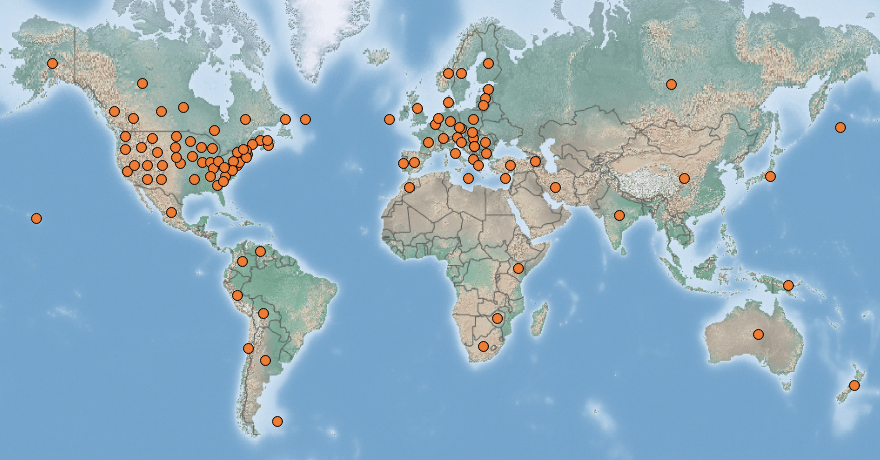 |
Brook trout | Status LU: established. 1st record: 1872. |
 |
Bur-Séifrell1 | Status Eur.: established. |
 |
Truite mouchetée | RA: ISEIA: C1. Harmonia+: n/a. |
 |
Bachsaibling | Wikipedia: |
 |
Bronforel | Back to the list of vertebrates |
Contents
Report the species
→ Report Salvelinus fontinalis to the National Museum of Natural History.
Brief description
 Introductions of Salvelinus fontinalis (Mitchill, 1814) began in the nineteenth century, to more than 40 countries in temperate areas on all continents, including the southern hemisphere. The brook trout is considered a poor to moderate invader. Potential impacts include predation on various species of amphibians, zooplankton and other invertebrates as well as increases in primary productivity, alteration of nutrient cycles, and hybridization with native species. This species is competitive, with broad dietary breadth, has a fast growth rate, often lacks predators or parasites, and is moderately tolerant of abiotic conditions. Introductions may lead to replacement of native salmonids (e.g. brown trout, Salmo trutta) (CABI 2019).
Introductions of Salvelinus fontinalis (Mitchill, 1814) began in the nineteenth century, to more than 40 countries in temperate areas on all continents, including the southern hemisphere. The brook trout is considered a poor to moderate invader. Potential impacts include predation on various species of amphibians, zooplankton and other invertebrates as well as increases in primary productivity, alteration of nutrient cycles, and hybridization with native species. This species is competitive, with broad dietary breadth, has a fast growth rate, often lacks predators or parasites, and is moderately tolerant of abiotic conditions. Introductions may lead to replacement of native salmonids (e.g. brown trout, Salmo trutta) (CABI 2019).
Status and distribution in Luxembourg
Records of Salvelinus fontinalis Mitchill, 1814 in Luxembourg. Data source: Recorder-Lux, iNaturalist & GBIF, 2024-10-22.
Salvelinus fontinalis (Mitchill, 1814) was first mentioned in 1872 by Alphonse de la Fontaine, who wrote that the brook trout occasionally enters the Moselle from time to time (De la Fontaine 1872).
The species was introduced in Luxembourg in 1902 in Limbach (Lintgen), Rollingerbach and Berschbach (Feltgen 1902).
In 2005, a systematic inventory of Luxembourg rivers only showed isolated individuals in the Alzette. There is no indication of reproduction of the species in Luxembourg.
The distribution map is not complete because records still have to be entered into the Recorder-Lux database (MNHNL, iNaturalist & GBIF 2019).
Currently, 6 records of in Luxembourg are accessible through the MNHNL-mdata portal (MNHNL, iNaturalist & GBIF 2020).
Risk assessment
ISEIA protocol
C1 (1+1+1+1) (Ries et al. 2014: 199).
Harmonia+ protocol
Not assessed yet.
Worldwide distribution
Bibliography
- Administration de la gestion de l’eau, 2010. Les poissons au Luxembourg, Cartographie des poissons, lamproies et écrevisses du Grand-Duché de Luxembourg. 2e éd. 213 pp.
- CABI, 2019. Salvelinus fontinalis (Mitchill, 1814). In: Invasive Species Compendium. Wallingford, UK: CAB International. URL: www.cabi.org/isc [accessed 2020-04-23]
- De la Fontaine, A., 1872. Faune du Pays du Luxembourg. Poissons. Publ. Inst. Roy. Gr.-D. Luxb. 8: 1-88.
- Feltgen, E., 1902. Vademecum des Luxemburger Fischereiliebhabers. P. Worré-Mertens, Luxemburg. 148 S.
- Klees, H., 1981. Luxemburger Tiernamen. Beiträge zur luxemburgischen Sprach- und Volkskunde XIV. Institut grand-ducal, Section de linguistique, de folklore et de toponymie. 2. Aufl. 131 S. Imprimerie Pierre Linden, Luxembourg.
- MNHNL, iNaturalist & GBIF, 2019. MNHNL-mdata, online portal combining species observation from Recorder-Lux, iNaturalist and GBIF. National Museum of Natural History, Luxembourg. URL: https://mdata.mnhn.lu [Accessed 2019-10-25]
- Ries, C., M. Pfeiffenschneider, Engel, E., J.-C. Heidt & M. Lauff, 2014. Environmental impact assessment and black, watch and alert list classification after the ISEIA Protocol of vertebrates in Luxembourg. Bull. Soc. Nat. luxemb. 115: 195-201. [PDF 247 KB]
Suggested citation of this webpage
Ries, C. & M. Pfeiffenschneider (Eds.), 2024. Salvelinus fontinalis (Mitchill, 1814). In: neobiota.lu - Invasive Alien Species in Luxembourg. National Museum of Natural History, Luxembourg. URL: https://neobiota.lu/salvelinus-fontinalis/ [Accessed 2024-10-22].
Page content last updated on 2020-04-27.
- Saibling cf. Klees 1981: 26.[↩]


